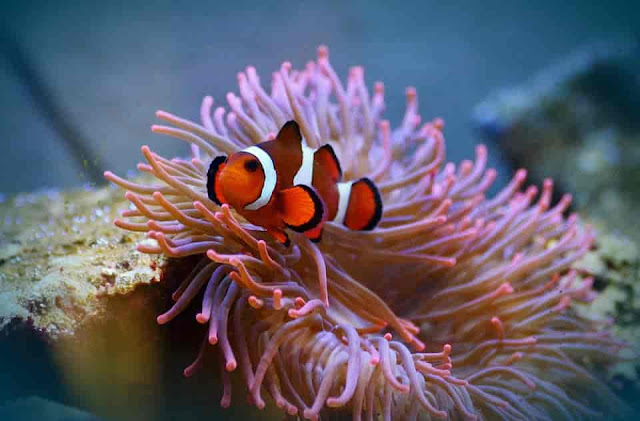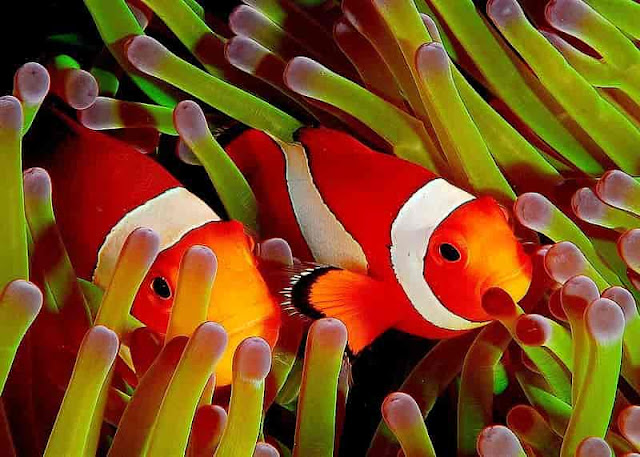Clown Fish
Bright orange with three striking white
bars. Clown anemone fish are some of the best-known reef inhabitants.
Clownfish aquarium
Setting up a
clown fish aquarium is virtually the same as preparing a tank for any marine
life. The only difference will be in the tank's size. A pair of clowns can
thrive in a 30-gallon tank if they are the only marine life other than your
clean-up crew. With this size tank, you won't need to spend hundreds or even
thousands on equipment to keep the conditions optimal.
What You Will
Need
Tank - Minimum
30 Gallons(
Water - Reverse
osmosis water is best and can be purchased
Sand - 1 lbs.
per
Filter -
Optional
Protein Skimmer
Pump - 1 -2
Heater - 75
Watts per gallon (roughly)
Lighting - 1-2
fluorescent bulbs should be do
Marine Salt
Thermometer
Refractometer -
This test the amount of salt within your water (gravity)
Ammonia,
Nitrite, Nitrate
First, you'll
want to clean everything that will go into the clown fish aquarium by soaking them in a
saltwater bath, then rinse them with another fresh saltwater mix. Next, find
the location in which your tank will be placed
After you have
all of your equipment cleaned and your tank is resting in a permanent location,
you will want to add the live rock. Adding the rock before the sand will ensure
that any digging that may occur near the base of your rock will not cause a
potentially fatal collapse. Once you have your rock situated, it is time to add
sand. It is recommended of
Now we need to
mix our saltwater. Using a brand new container to prevent contamination, begin
adding your water. Slowly add salt per the manufacturer's specifications while
checking the gravity frequently with your refractometer. You will also want to
add your pump into the container and let it aerate overnight to remove excess
CO2. You can add your heater to get the water up to temperature during this
process.
Using a
sanitized plate or bowl at the bottom of your tank to avoid destroying your
sand bed, slowly add the seawater mix to your tank, aiming for said plate/bowl.
Fill your tank to within about 6-8 inches from the top to avoid overflow when
adding the rest of your components. Once you have it filled, we will begin adding
the rest of your equipment.
First, add your
heater. Be sure not to plug this in before it is completely submerged skimmer At that time you
Now your
clown fish aquarium is all set up and running, but it isn't quite efficiently, keeping an eye on it
Clown fish aquarium setup
Clownfish are easy to feed, fairly resistant to
disease, and can tolerate less than ideal water conditions.
All saltwater fish come from the ocean, and in the
ocean there are currents. Most saltwater fish we keep in our
aquariums come from the shallow reefs where the currents are relatively strong.
In the aquarium, the current need powerhead 20 gallon hvlp powerhead
As for lighting, saltwater fish do not
have special lighting requirements. The less intense light they have, such as a
fluorescent light, the less be used they are used Although prolonged as well
as Over really hot
Clownfish facts
Clownfish are already one of the most popular
captive marine fish due
to
All clownfish are born as males. As they grow older,
Aside from the trademark colors and striping, clownfish also display a distinguished swimming style. Clowns swim by rotating their pectoral fins
As you may have noticed by now, these fish seem to pride themselves on being abnormal. They stay true to this bizarre mentality in the way they
There are just a few of the
Care of clownfish
Clownfish
are a very popular saltwater fish. They are very peaceful and colorful
additions to the aquarium. Clownfish
are normally found Western Pacific Ocean . Clownfish have been growing in
popularity over the years to become one of the most kept saltwater fish. Before
you start
to a
couple of
Clownfish
Once you get the hang of the basics,
You should provide a mate for your clownfish. Clownfish do much better in pairs, and they can also produce their offspring in the aquarium. Clownfish have an amazing ability to switch sexes, but all clownfish are first born as males. You can pair a male and a female together and then breed them to keep or sell their offspring.
It is quite a sight to see parent clownfish swimming around with their litter in the aquarium. The fry will take some time to grow up, and if you are serious about breeding your clownfish, there are some very interesting and in-depth guides on the internet that I would recommend looking at.
I hope you found this article helpful in your pursuit of owning clownfish. Anemones
Clown fish breeding
 |
| Clown Fish |
Do you know that clownfish mating is very
fascinating because these fishes, during the mating season, will be
having
Clownfish
have 3 major school categories, the largest which is the female and the second
largest is the male school and the third will be juveniles and gender-neutral. When
mating and if some adults are not present, clownfish males will become female
and a juvenile will turn into a male to cope up
To breed clownfish, consider the
following
Set-up the
breeding place. Have a piece of ceramic in your tank so that the fishes will
have a spawning spot. Have a heater and a timer for the day and night cycle.
For trivia, the "stalk" at the base of a clownfish egg is
made up of for
this reason .
During the
hatching day, keep the tank sufficiently oxygenated so that the males will have
enough oxygen when they are guarding the nest and fans the eggs. First laid
eggs are in a bright orange color, when the color fades, the eyes will appear when it turns silver, it is now time to hatch. When the
larvae hatches,
Keep the eggs
aerated gently with an air stone or else fungus will set in
For the
larvae tank, have a container filled with a 5-10 gallon on oxygenated water, set up a
heater and an air stone. Additionally,
you
Have a steady
light, on for the next few days will also be necessary, this will help the
larvae to learn their hunting skills. The first ten days of the larvae's life
are very crucial and stressful because of the occurrence of metamorphosis. Be
ready for this event because these are the days where many larvae die. The
fingerlings will then develop their stripes after this stage, and you can now
go back to your regular clownfish care.
did not discover conditions of artificial light
affect the surrounding reefs, which Another problem is that
Effects coastal reefs can spread to the surrounding reefs.
the orientation (not directed outwards but downwards) can help reduce the effects clownfish animals. Similar rules have
Clownfish eggs
Light
pollution occurs when artificial light interferes with ecological systems or
processes, usually at night.
Natural
light at night, produced by the moon, stars, and other celestial bodies in
comparison
Because
nearly all organisms on Earth have evolved with a stable day-night, light and
dark cycle, many biological events are
now highly attuned
But
artificial light can mask these natural light rhythms and interfere with the
behavior and physiology of individual creatures, as
a whole
The
ocean is not exempt from these problems. Light pollution is spreading to marine
habitats through urbanized coastlines and increasing marine infrastructure such
as piers, harbors, cruise ships, and tropical island resorts where bungalows
extend out into the lagoon, directly above coral reefs.
Why are clownfish at
risk?
Clownfish,
like many reef fish, are particularly
Once clownfish find a
suitable anemone, they stay put forever.
This
means that if a fish chooses an anemone on a shallow reef in an area that is
heavily lit at night, they will experience chronic exposure to light pollution
throughout their life; They won’t just move away.
Clownfish
also lay their eggs attached to a rock or other hard surfaces, so in areas
exposed to light pollution the eggs will experience continuous artificial light
(as opposed too many fish that lay and fertilize eggs in open water, so they
are immediately carried away by ocean currents).
What we found
To test how artificial light affects
clownfish reproduction, we can examine the common clownfish for the experiment.
Five breeding pairs of fish
experienced a normal 12-hour daylight, 12-hour dark cycle, while another five
pairs of fish had their “night” period replaced with 12 hours of light at 26.5
lux, mimicking light pollution from an average coastal town.
For 60 days, we monitored how often
the fish spawned, how
many eggs were fertilized fertilization on hatch
Clownfish attach their eggs to rocks or other hard surfaces,
leaving them at the mercy of their immediate environmental conditions.
Why does Nemo the clownfish have three white stripes?
At the end of the experiment, we
removed the artificial light and monitored the fish for another 60 days to see
how they would recover. As soon as the
light at night was removed
Clownfish, like many reefs 5mm
Our findings show that the
presence of process, – – that artificial
Healthy, fertilized clownfish eggs did not hatch in the
presence of artificial light.
Light pollution is one of the most
pervasive forms of environmental change. About 23% of the land surface
(excluding the poles) and 22% of coastal regions are
exposed
And the problem is only growing. The
reach of light pollution across all land and sea is expanding at an estimated
rate of 2.2% per year, and this will only increase with the rising global human
population.
Although research on the ecological
impacts of light pollution are arguably only in its infancy, the evidence for
negative consequences for a range of insects, birds, amphibians, reptiles,
and mammals, including humans, are stacking up.





